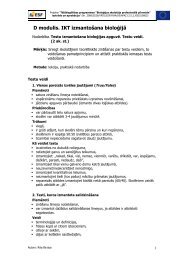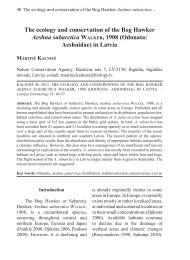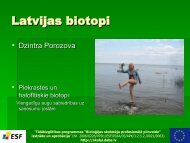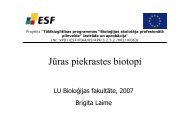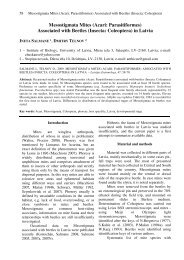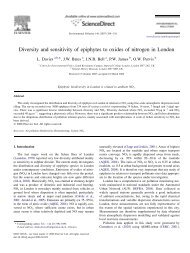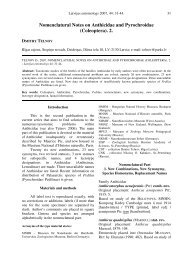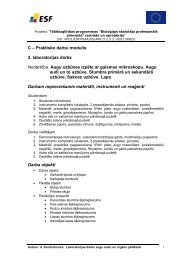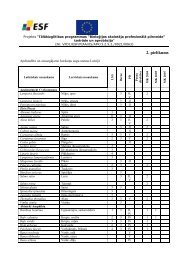Dissolved organic matter in water of Daugava river
Dissolved organic matter in water of Daugava river
Dissolved organic matter in water of Daugava river
Create successful ePaper yourself
Turn your PDF publications into a flip-book with our unique Google optimized e-Paper software.
Fluorescence Study <strong>of</strong> Cytochrome c B<strong>in</strong>d<strong>in</strong>g to Model MembranesV.Trusova *1 , G.Gorbenko 1 , J.Molotkovsky 2 , P.K<strong>in</strong>nunen 31 V.N. Karaz<strong>in</strong> Kharkov National University, Kharkov, Ukra<strong>in</strong>e;2 Institute <strong>of</strong> Bio<strong>organic</strong> Chemistry, Russian Academy <strong>of</strong> Sciences, Moscow, Russia;3 School <strong>of</strong> Science and Technology, Aalto University, Espoo, F<strong>in</strong>lande-mail: valtrusova@yahoo.comCytochrome с (cyt c) is a small highly basic hemoprote<strong>in</strong> abundant <strong>in</strong> the <strong>in</strong>termembranespace <strong>of</strong> mitochondria and possess<strong>in</strong>g two at first glance unrelated functions. First, cyt с isan essential component <strong>in</strong> respiration, shuttl<strong>in</strong>g electrons from cyt c reductase (bc1complex) to cyt c oxidase. The second function <strong>of</strong> cyt c relates to its key role <strong>in</strong> theactivation <strong>of</strong> the apoptotic cascade, result<strong>in</strong>g from the release <strong>of</strong> this prote<strong>in</strong> frommitochondria <strong>in</strong>to the cytosol. It is generally established that control <strong>of</strong> the b<strong>in</strong>d<strong>in</strong>g <strong>of</strong> cytc to the <strong>in</strong>ner membrane <strong>of</strong> mitochondria (IMM) is <strong>in</strong>volved <strong>in</strong> both <strong>of</strong> the abovefunctions. Despite the diversity <strong>of</strong> lipids constitut<strong>in</strong>g the mitochondrial membrane, centralto the cyt c – membrane <strong>in</strong>teraction <strong>in</strong> IMM is cardiolip<strong>in</strong> (CL), which is <strong>in</strong>dispensible forthe retention, stability and physiological function<strong>in</strong>g <strong>of</strong> cyt c. In this regard, the nature andspecificity <strong>of</strong> <strong>in</strong>teractions between cyt c and CL attract particular <strong>in</strong>terest. In the presentstudy fluorescence resonance energy transfer (FRET) between anthrylv<strong>in</strong>yl-labeledphosphatidylchol<strong>in</strong>e as a donor and heme moiety <strong>of</strong> cytochrome c (cyt c) as an acceptorhas been employed to explore the prote<strong>in</strong> b<strong>in</strong>d<strong>in</strong>g to model membranes, composed <strong>of</strong>phosphatidylchol<strong>in</strong>e (PC) and CL. The existence <strong>of</strong> two types <strong>of</strong> prote<strong>in</strong>-lipid complexeshas been hypothesized where either deprotonated or partially protonated CL molecules areresponsible for cyt c attachment to bilayer surface. To quantitatively describe cyt cmembrane b<strong>in</strong>d<strong>in</strong>g, the adsorption model based on scaled particle and double layertheories has been employed, with potential-dependent association constants be<strong>in</strong>g treatedas a function <strong>of</strong> acidic phospholipid mole fraction, degree <strong>of</strong> CL protonation, ionicstrength and surface coverage. Multiple arrays <strong>of</strong> FRET data obta<strong>in</strong>ed under conditions <strong>of</strong>vary<strong>in</strong>g pH, ionic strength, CL content and prote<strong>in</strong>-to-lipid molar ratio have been analyzed<strong>in</strong> terms <strong>of</strong> the model <strong>of</strong> energy transfer <strong>in</strong> two-dimensional systems comb<strong>in</strong>ed with theadsorption model allow<strong>in</strong>g for area exclusion and electrostatic effects. The set <strong>of</strong>recovered model parameters <strong>in</strong>cluded effective prote<strong>in</strong> charge, <strong>in</strong>tr<strong>in</strong>sic associationconstants and heme distance from the bilayer midplane for both types <strong>of</strong> prote<strong>in</strong>-lipidcomplexes. Upon <strong>in</strong>creas<strong>in</strong>g CL mole fraction from 10 to 20 mol % (the value close tothat characteristic <strong>of</strong> IMM) the b<strong>in</strong>d<strong>in</strong>g equilibrium dramatically shifted towards cyt cassociation with partially protonated CL species. The estimates <strong>of</strong> heme distance frombilayer center suggest shallow bilayer location <strong>of</strong> cyt c at physiological pH, while at pHbelow 6.0 the prote<strong>in</strong> tends to <strong>in</strong>sert <strong>in</strong>to membrane core. These f<strong>in</strong>d<strong>in</strong>gs support theviewpo<strong>in</strong>t that hydrogen bond<strong>in</strong>g <strong>of</strong> cyt c to protonated phosphate can be coupled with theformation <strong>of</strong> electrostatic contacts with deprotonated phosphate. Structural features <strong>of</strong> cytc do not exclude such a possibility. Cyt c molecule has two hydrophobic channelsconnect<strong>in</strong>g heme crevice with the prote<strong>in</strong> surface. The open<strong>in</strong>g <strong>of</strong> one <strong>of</strong> these channels issurrounded by oppositely located Asn 52 and Lys 72 , Lys 73 . It has been hypothesized that cytc association with CL <strong>in</strong>volves hydrogen bond<strong>in</strong>g <strong>of</strong> one protonated phosphate moiety toAsn 52 with simultaneous electrostatic b<strong>in</strong>d<strong>in</strong>g <strong>of</strong> deprotonated phosphate to lys<strong>in</strong>e residuesand accommodation <strong>of</strong> one acyl cha<strong>in</strong> with<strong>in</strong> the hydrophobic channel.This work was supported by the grants from European Social Fund (project number2009/0205/1DP/1.1.1.2.0/09/APIA/VIAA/152) and Fundamental Research State Fund <strong>of</strong>Ukra<strong>in</strong>e (project number F.41.4/014).- 32 -



